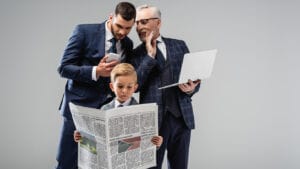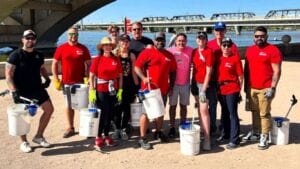Arizona communities are battling a “severe teacher shortage,” according to a recent Arizona School Personnel Administration (ASPAA) study that revealed 81% of Arizona teaching positions are sitting vacant or filled by an educator who does not meet the state’s standard teaching requirements.
While a teacher shortage is not new for Arizona schools, the COVID-19 pandemic is, and it is one of the main reasons teachers are experiencing burnout and choosing to leave the profession, according to Arizona Education Association (AEA) president Joe Thomas. Safety concerns, intensified workloads, retaliation from the public and a weakening voice in the state’s plan to move forward with in-person instruction has brought teachers to question whether or not a career in Arizona’s school system is worth it anymore.
Arizona currently has one of the worst teacher-to-pupil ratios in the nation, according to a 2021 WalletHub study, but educators had some of the highest class sizes and lowest wages even before the pandemic hit, Thomas said.
READ ALSO: How Downtown Phoenix restaurants are implementing mask policies
Not only does this become an issue for creating working conditions with competitive pay that make people want to become educators in Arizona again, but it also becomes a safety concern for students and teachers returning back to the classroom for in-person instruction.
“When you go back and look at what the CDC…would tell you to avoid—prolonged exposure with a large group of people, don’t be in small rooms that aren’t ventilated well and make sure that you’re masked and socially distant—those don’ts describe our classrooms,” Thomas said.
Depending on grade level and teacher or substitute availability, Arizona schools have had to cram anywhere from 25 to 40 students into one classroom at a time, Thomas said. Educators have had a difficult time safely teaching in these small, crammed environments with Arizona’s current ban on mask mandates.
“In an elementary school, our kids cannot get vaccinated yet. That is very stressful,” said Kelley Fisher, a Deer Valley kindergarten teacher who has been teaching for over 20 years. “I have had more students out sick…and I’ve had more COVID cases this year than I did all of last school year, and we’re just finishing the first quarter.”
The ban on mask mandates has not only become a safety issue for students and teachers, but it also has interrupted the quality of education students are receiving.
“We’re finding students who have gaps in their skills and knowledge…and it’s been different for each student because of when and how the pandemic affected them,” said Tori Schroeder, Sunnyside Education Association president and classroom teacher. “If they got COVID at one time or somebody in their family got COVID at one time, their attention got taken away from school, and it’s not the same unit or the same lesson for everybody.”
“It is really difficult to try to manage…the constant rotating door of absent students,” Fisher said. “I really feel like if we had masks on, some of that would be alleviated.”
Educators are not only noticing an education gap in their students, but also a social and behavioral one, especially at the transitional periods.
“We know from our district data that at the eighth and ninth grade levels we have more students who have been having behavioral disruptions,” Schroeder said. “Those are students who, the last time they had a normal school year, were in elementary, so they missed a sort of normal social development [period].”
This social and behavioral gap is also being reflected in students in the younger grades who are just now getting used to this form of social adjustment.
“Last year when we started online and came back into school in October, we realized that all of those beginning skills that you teach like how to hold a pencil, how to use your scissors, how to open and use a glue stick and a glue bottle had not been taught,” Fisher said. “The other thing that we noticed was that they were missing that socialization…and they didn’t really know how to play with each other or how to talk to each other outside of the Zoom room.”
The academic as well as social and behavioral gaps teachers are working to fill for students at thing time has been difficult to do while keeping up with this year’s curriculum.
“Right now, instead of a plate, we are all balancing 10 platters full of things to make sure that our kids are okay,” Fisher said. “And there are a lot of days when I go home thinking I dropped every platter.”
In addition to adjusting to new classroom challenges, teachers have been met with outside political factors that have added a new level of stress to the profession.
“[Teacher burnout] is not just from teaching during COVID alone,” Thomas said. “You add in this whole layer of these activist, politicized parents that are coming to board meetings—some of them who don’t even…have children in the schools—and are threatening board members or threatening superintendents, and we’ve had superintendents and governing board members resign because they feel that their families or that they are threatened.”
Teachers say this level of discourse and polarization in the school system has been unique to the COVID-19 pandemic.
“I truly think that there was always a lot of support and respect for educators, but if you look at the fact that once the pandemic hit and we started speaking up about not wanting to teach in an unsafe environment, everything became political and then it was us versus them,” Fisher said.
“It feels like the community has turned on you when all you’re trying to do as a classroom teacher is keep your kids safe and get them just a little bit smarter than they were yesterday,” Thomas said.
When asked what students, families and Arizona citizens could do to support educators during this time, the answer was the same across the board: “Trust us.”
“We want what’s best for your child,” Thomas said. “When you have educators that have worked in a state like this for as long as they have, they’re in it for the students.”
“When we know that we’ve made a choice in the best interest of the students, it’s important to be able to hear it,” Schroeder said. “Because our perspective is unique,”
“It’s rough right now and it’s exhausting, but I still love it,” Fisher said. “I think every teacher would probably say that all the other extraneous stuff is a lot…but the saving grace is the students.”



